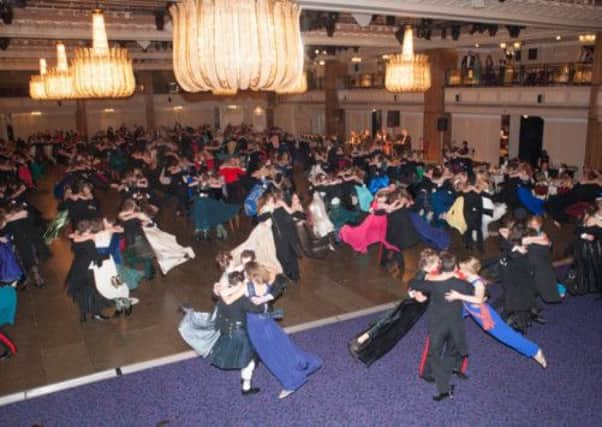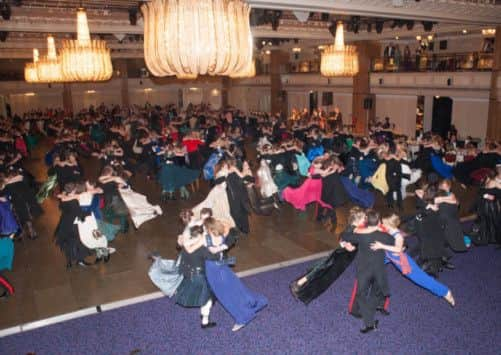The Royal Caledonian Ball keeps it reel in London


‘WELCOME,” says Lord Biddulph with a waggle of his estimable eyebrows, “to the best ball in Scotland! Um, in London!” Lord Biddulph, known to his chums as Nick, is 54, loose-limbed, loose-tongued, altogether loose, a jolly, rose-cheeked Toby jug of a man, full to the brim of bonhomie, with a foaming head of fun. Down from the Borders for the evening and intent on a good time, he is short, stout, his faith in reeling devout, and he seems perpetually to be on the move – dancing, mingling, slipping his arm around a beautiful lady or two (and introducing them as such) or slapping some good old fellow on the back. His trajectory is always joywards. It is as if someone fired a cannonball in 1959 and it hasn’t come down since. His kilt, in Cunningham tartan, is by his estimate a century old, but wears its years well, as does its wearer. “Youmusthave the odd drink,” he advises, conspiratorially. “But you mustn’t have too much or you forget the steps, you see.”
The Royal Caledonian Ball is the oldest charity ball in the world. It is the one night of the year when Scotland’s high society descend on London, in their hauteur and couture, for dinner, drinks and most of all for dancing. These are people who were instructed in the finer points of the Dashing White Sergeant as soon as they could walk, and for whom the free whisky on every table seems to function as rocket fuel, carrying them smoothly through Friday night and into the orbit of Saturday morning. Later, following the start of the grouse season, will come a string of balls in Scotland – among them Oban, Skye, Angus, Perth, Lochaber and the Northern Meeting. But that is for another day.
Advertisement
Hide AdTonight is the 165th Royal Caledonian Ball. It was inaugurated in the Victorian era by the Duke and Duchess of Atholl as a pick-me-up for their homesick Scottish friends in London, a whiff of the Great Glen in the midst of the Great Wen. It has been held most years since, except during the Boer and World wars and following the death of Edward VII. No matter the decade, no matter the century, everyone always has a wonderful time, the only possible exception being the ball of 1997; it took place on the evening of Tony Blair’s landslide which, I’m told, cast rather a pall over proceedings. Since 1930 the ball has been held at Grosvenor House on Park Lane, the hotel with the biggest, grandest ballroom in London, certainly capable of accommodating the 700 or so guests here tonight. Tickets cost between £135 and £225 and benefit several Scottish charities. The guest list is a spectacle in itself. It is a pleasure to lean over the balcony, look down at the blue blood on the dancefloor, and wonder which lovely lady is Miss Victoria Pentecost, which Mrs Imogen Lyndon-Skeggs, and which Fanny, Lady MacGregor of MacGregor.


On the door, in a natty tartan bow-tie, is Terry Kemp, 66, the retired chauffeur of Viscount Dupplin. His job is to check the tickets and that each guest is attired correctly. There is a strict and rather complex dress code. Gentlemen are expected to wear Highland evening dress, evening tails with white tie, or mess kit. Dinner jackets are verboten. Ladies should wear floor-length evening dress; tiaras and tartan sashes are optional but encouraged. There are, of course, little individual flourishes here and there. One handsome young man, Peter Taylor, a student of art history at St Andrews with more than a touch of Sebastian Flyte about his appearance, is sporting an extraordinary detachable fur collar over his tail suit. Is it fake fur? He shakes his head. “Raccoon.”
I arrived early, in time for the drinks reception at which viscountesses with flowing tresses dipped long-taloned fingers into glass bowls of nibbles and popped them, sparingly, between glossy lips. I was keen to talk to the staff, in particular to Miho Barbarich, 63, who brings to his role as floor manager the steely command of a regimental sergeant major with the unflappable poise of a Zen master. I asked one of his colleagues to point him out to me, and this was what they said: “He is bald. And he is Miho.”
It was sufficient. He is indeed bald and he is indeed Miho. He is also a legend in the hospitality trade. He moved to London from his native Dubrovnik 45 years ago, finding work first at the Savoy, cleaning glasses, before rising, like a perfect soufflé, to his current eminence at Grosvenor House. “Everything has to be perfect. In this business, everything you do has to be precise and planned in advance, and the timing is paramount,” he tells me, flourishing a complicated document that looks like a football manager’s tactical diagram. “But when the dancing starts, it is something mag-nee-fee-cent.”
Upstairs, in a room off the balcony, the pipes and drums of the London Scottish Regiment are preparing to perform, some of them sipping bottled lagers or whisky and ginger ale, others getting into uniform. Four leopardskins, part of the get-up of the drummers, hang on a clothes rail like onesies. These were once real leopards, shot back in the days when such things were still acceptable, and each has been given a nickname by the band. One skin of particularly high quality is known as Rizla.
Rob Green, a 29-year-old Londoner, is standing in T-shirt and underwear, ironing his plaid. He used to be a Highland dancer but found there was more beer to be had in a pipe band. Although he himself is English, his grandmother was from Glasgow and his great-grandfather came from Lewis. “That’s a beautiful story,” jokes a passing drummer. “It almost makes up for how shit you play the pipes.”
Advertisement
Hide AdDrum Major David Foulis, known as Nobby, is a 66-year-old Glaswegian, specifically a Partick man, and has been in the army since joining the Argyll and Sutherland Highlanders at 17. His barrel-broad chest is bright with campaign medals – Northern Ireland, South Arabia, Malay Peninsula, Borneo – and each hand has a fading tattooed swallow, souvenirs of Singapore. “I was in the Crater with Mad Mitch,” he says, referring to his 1967 posting in Aden, fighting nationalist insurgents under the command of Lieutenant Colonel Colin Mitchell. “Anything for the troops, that guy. Charisma coming out his arsehole.”
Nobby gives the strong impression of being considerably tougher than the toughest pair of old boots one might hope to find, mentioning in passing that just four weeks ago he suffered a “wee haemorrhage” of the brain. I can’t believe you’re here tonight, I tell him. “Neither can my wife,” he grins.
Advertisement
Hide AdAt 10pm, wielding his mace, Nobby leads out the band, playing Scotland The Brave, to mark the start of the ball. The London Scottish Regiment are followed by the set reels, a prelude to the dancing proper, in which the most accomplished dancers strut their stuff. Ralph Anderson, an earnest 27-year-old resplendent in a lace jabot, urges his party down the stairs to the dancefloor with the stern passion of an officer ushering paratroopers out the door of a plane: “Right! Go! Go!” Ralph – pronounced “Rafe” – hails from Selkirkshire and works for a stockbroker. One must “take a strict line” when instructing dancers, he says. “It requires military precision.” He himself was taught by his father to dance at the age of two – “There’s pictographic evidence” – and considers reeling to be an artform. “If the alternative is going to a disco and getting drunk and shaking your body around, well ...” Ralph pulls a face of profound revulsion. The Bee Gees must give him the heebie-jeebies.
Children of some of the guests have been allowed to stay up late and watch the set reels from the balcony, while they themselves are watched over by nannies, around a dozen Mary McPoppinses in ballgowns. “Can you see mama?” one asks her charge, a little girl wearing a tartan sash and a pronounced pout. “Hmmph!” says this child, unimpressed. “There’s more clapping at my school assembly!”
To be fair, that must be some wild school assembly, because the Royal Caledonian Ball is a foot-stomping bacchanal from start to finish. There is a break at half-past midnight for a restorative breakfast of kedgeree and porridge spooned from silver servers by white-jacketed waiters, but then it’s once more unto the breach until after three in the morning. A woman is on hand to repair ripped gowns and split troosers. Glengarries lie on tables next to Prada clutches.
Seen from the balcony, the ball is a skirling, whirling kaleidoscope of tartan and tiaras as everyone does their damnedest to put the “crazy” into aristocracy. Every opening accordion chord from the Simon Howie Broadcasting Band is met by a groan of mixed agony and ecstasy as yet another reel begins. The most impressive mover of all is Euan Ivory, a rather burly, genial young chap from Glenisla with mirth to match his girth, and grace to match his mirth, who floats like a butterfly, lowps like a flea, birls his partners like so many roulette wheels, and generally treats the dancefloor as though it were his fiefdom and he its feudal master.
The last person I see before leaving, just after everyone has sung God Save The Queen, is the Lord Biddulph. He, clearly, does not intend to return to Kelso empty-handed. “Hey!” he calls over to one of the waiters, who is beginning to clear up. “I’m taking the whisky!” «
Twitter: @PeterAlanRoss